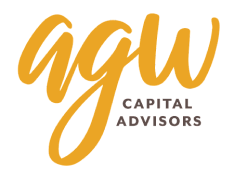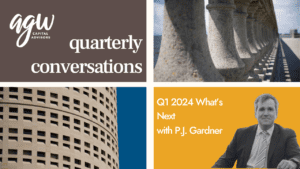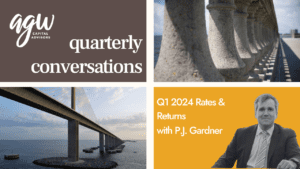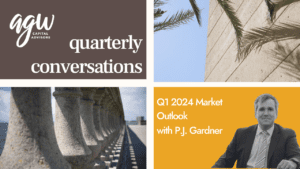Quarterly Conversations – 2024 Beyond Recession
In this video, AGW Principal & Co-Founder P.J. Gardner, CFA®, CFP®, assesses recession risks, economic indicators, consumer resilience, and fiscal policy to provide an informed economic outlook. This conversation was recorded on February 1, 2024, and reflects information available at that time.
Audio Only
Highlights
- Recession Predictions and Economic Indicators: AGW evaluates the potential for a recession, citing leading economic indicators and the inverted yield curve as traditional harbingers. Despite some predictions of avoiding economic downturn, the firm presents a cautious outlook based on historical precedents and current market conditions.
- Consumer Resilience and Fiscal Policy: The resilience of the U.S. consumer is highlighted as a surprising factor, bolstered by government stimulus. However, concerns about decreasing savings rates and the implications of a tight job market on inflation are discussed.
- Government Spending and Debt: The conversation covers the U.S. government’s significant deficit spending and its impact on the economy. AGW expresses concern over the sustainability of such fiscal policies, especially given the normalization of interest rates and the potential for increased government borrowing costs.
Full Transcript
So another big question is, are we going to enter a recession or not. And as I mentioned before, consensus is we’re going to stick the landing stick this soft landing, where we don’t feel much economic pain, you know, economically in the United States, maybe. And as I’ve said, I think when it comes to finance and economics, you’ve got to think probabilistically, and not in absolutes. So I would put maybe some, some probability that that is possible. But it would be unlike anything we’ve ever seen before.
You look at sort of some of the key indicators that have preceded recessions in the past, the Conference Board has a set of leading economic indicators, those have been negative, and not just for a little while, they’ve been negative now for 20 months. Other times where we’ve seen that in the mid 70s, we went 25 months, in the global financial crisis, for example, we went 24 months.
So those are sort of big economic indicators that are commonly followed, that are flashing if not red, at least yellow. Another thing that you see is yield curve inversion. And again, the Fed funds rate is five and a half percent, and then slopes down from there. And it’s very restrictive monetary policy, and it tends to slow an economy, we’re now approaching a year of an inverted yield curve.
One of the theories put forth as well, we’ve been experiencing these rolling recessions. And I would say there’s some truthiness in that, certainly the housing sector was affected when mortgage rates spiked over 7%, you can look at manufacturing, you can look at services and all them in now the goods economy slowing, all those are have experienced certain declines.
The biggest surprise that people have tried to get their head around is the resilience of the US consumer. And if there’s one thing that we do really well in the United States has been spending money. And of course, as we know, the government fiscally flooded consumers with cash.
Everybody agrees that the savings rate has plummeted. And they’re burning through cash, they the consumer at a pretty good clip. And so the cash is running now. And then if you look beyond that, it, it appears that a number of consumers have sort of already run out of cash.
The job market still remains incredibly tight. But if you think about that, that also has a negative side to that coin, which is a really tight job market tends to also be inflationary, and think of wages and the pressure that puts on wages.
Inflation clearly has started to move down. A big open question is moving from something like nine to call it for three? Was that a lot easier than called the last mile of getting it down to their 2%? Target?
The government spent a lot of money last year. So if you look at its fiscal year, it’s been $1.7 trillion in a single year deficit spending. So you just think about that, that’s 6% of GDP over 6% of GDP alone, our total debt over 30 trillion.
This is a time when fiscally you should be running surpluses. And in fact, you will recall we did, gosh, only 2025 years ago, but instead we’re running some of the biggest deficits we’ve ever had. And as interest rates normalize, one of the things to be looking at is just how much interests interest expense alone that the government has to pay starts to make up the budget.
AGW Capital Advisors is a registered investment adviser. Information presented is for educational purposes only. It should not be considered specific investment advice, does not take into consideration your specific situation, and does not intend to make an offer or solicitation for the sale or purchase of any securities or investment strategies. Investments involve risk and are not guaranteed. Be sure to consult with a member of the AGW team, another qualified financial adviser, and/or tax professional before implementing any strategy discussed herein.





